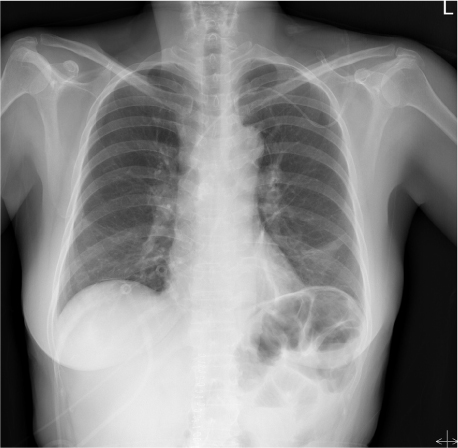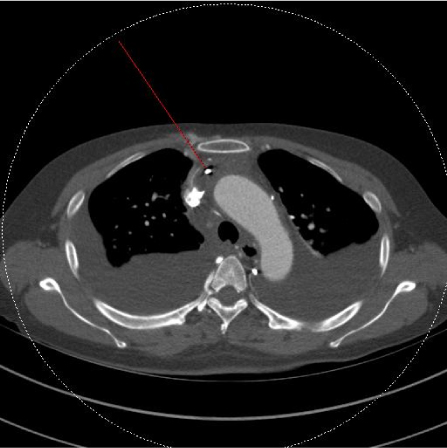J Dent Anesth Pain Med.
2015 Mar;15(1):31-34.
Acute mediastinitis secondary to delayed vascular injury by a central venous catheter and total parenteral nutrition
- Affiliations
-
- 1Department of Anesthesia and Pain Medicine, Pusan National University Yangsan Hospital, Korea.
- 2Department of Dental Anesthesia and Pain Medicine, Pusan National University Dental Hospital, Korea. kejdream84@naver.com
Abstract
- Vascular injury caused by a central venous catheter (CVC) has been reported to be a rare complication, especially delayed vascular injury due to CVC has a few cases and it can be fatal because of delayed recognition and more serious complications. A 59-year-old woman with no available medical history was admitted for treatment of ovarian cancer. For the surgery, a triple-lumen CVC was placed through the left subclavian vein. Parenteral nutrition through the CVC was used for postoperative nutritional management in the first postoperative day. On the sixth postoperative day (POD), the patient suddenly complained of dyspnea. The CT revealed bilateral pleural effusion and irregular soft tissue density and air bubble in anterior mediastinum suggesting migration of the distal portion of the CVC into the anterior mediastium. In the intensive care unit (ICU) bilateral thoracentesis and percutaneous drainage were performed. She was discharged from the ICU in 3 days later and transferred to the general ward. This case emphasizes the possibility of the delayed vascular injury related to CVC and some strategies for prevention of vascular injury.
MeSH Terms
Figure
Reference
-
1. Walshe C, Phelan D, Bourke J, Buggy D. Vascular erosion by central venous catheters used for total parenteral nutrition. Intensive Care Med. 2007; 33:534–537.
Article2. Duntley P, Siever J, Korwes ML, Harpel K, Heffner JE. Vascular erosion by central venous catheters. Clinical features and outcome. Chest. 1992; 101:1633–1638.3. Defalque RJ, Campbell C. Cardiac tamponade from central venous catheters. Anesthesiology. 1979; 50:249–252.
Article4. Jones KW, Seltzer MH, Slocum BA, Cataldi-Betcher EL, Goldberger DJ, Wright FR. Parenteral nutrition complications in a voluntary hospital. JPEN J Parenter Enteral Nutr. 1984; 8:385–390.
Article5. Mukau L, Talamini MA, Sitzmann JV. Risk factors for central venous catheter-related vascular erosions. JPEN J Parenter Enteral Nutr. 1991; 15:513–516.
Article6. Valat P, Pellerin C, Cantini O, Jougon J, Delcambre F, Morales P, et al. Infected mediastinitis secondary to perforation of superior vena cava by a central venous catheter. Br J Anaesth. 2002; 88:298–300.
Article7. Inaba K, Sakurai Y, Furuta S, Sunagawa R, Isogaki J, Komori Y, et al. Delayed vascular injury and severe respiratory distress as a rare complication of a central venous catheter and total parenteral nutrition. Nutrition. 2009; 25:479–481.
Article8. Bersten AD, Williams R, Phillips G. Central venous catheter stiffness and its relation to vascular perforation. Anaesth Intensive Care. 1988; 16:342–351.
Article9. Ellis LM, Vogel S, Copeland E. Central venous catheter vascular erosions: diagnosis and clinical course. Ann Surg. 1989; 209:475–478.10. Marín MR, Rodríguez ME, Buleje JA, Valverde FM, Martínez MM, Pérez PP, et al. Acute mediastinitis due to extravasation of parenteral nutritional formula via a central venous catheter. Am J Crit Care. 2012; 21:296–299.
Article11. Peres PW. Positioning central venous catheters--a prospective survey. Anaesth Intensive Care. 1990; 18:536–539.12. Kim WY, Lee CW, Sohn CH, Seo DW, Yoon JC, Koh JW, et al. Optimal insertion depth of central venous catheters-Is a formula required? A prospective cohort study. Injury. 2012; 43:38–41.
Article
- Full Text Links
- Actions
-
Cited
- CITED
-
- Close
- Share
- Similar articles
-
- Fracture of an Implantable Central Catheter Due to Pinch Off Syndrome
- Delayed Pleural Effusion after Right Subclavian Vein Catheterization: A Case Report
- Arterial Puncture Unrecognized by Pressure Waveform Monitoring after Central Venous Catheterization: A case report
- A Safe Method of Central Venous Catheterization by Peripheral Venous Cutdown in Infants
- Intravascular kinking of catheter during central venous catheterization in a premature infant: A case report



